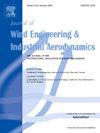Flow mechanism of a vibrating prism using the combined K-nearest neighbor and dynamic mode decomposition method
IF 4.9
2区 工程技术
Q1 ENGINEERING, CIVIL
Journal of Wind Engineering and Industrial Aerodynamics
Pub Date : 2025-02-02
DOI:10.1016/j.jweia.2025.106013
引用次数: 0
Abstract
This study proposes a novel hybrid method, K-nearest neighbor and dynamic mode decomposition (KNN-DMD), for capturing modes of vibrating prisms in the flow field. To validate the effectiveness of the proposed KNN-DMD, the velocity field under structural vibration amplitudes with 0%, 10% and 18% is obtained using large eddy simulation. KNN-DMD is utilized to identify dominant features of the flow field around the prism, such as low-frequency mode, the primary vortex shedding mode, second harmonic mode, and forced vibration mode. The low-frequency mode is associated with fluctuations in the incoming turbulent flow. The primary vortex shedding manifests as the periodic shedding of vortices in the wake region, revealing the dynamics of the shear layer and the process of shedding in the Kármán vortex street. The second harmonic mode, which is a higher-order form of the Kármán vortex street, supplements smaller-scale vortex structures and enriches the vortex characteristics. The forced vibration mode, reflecting the range and intensity of the vibration effect, forms shear layers that propagate to both sides and exhibit an alternate shedding phenomenon. The KNN-DMD reveals the structural modal forms in fluid dynamics more comprehensively and facilitates future research on the fluid-solid interaction and nonlinear stochastic systems.
结合k -最近邻和动态模态分解方法研究振动棱镜的流动机理
本文提出了一种新的混合方法——k最近邻和动态模态分解(KNN-DMD),用于捕获流场中振动棱镜的模态。为了验证所提出的KNN-DMD的有效性,通过大涡模拟得到了0%、10%和18%振动幅值下的结构速度场。利用KNN-DMD识别棱镜周围流场的主要特征,如低频模态、一次涡脱落模态、二次谐波模态和强迫振动模态。低频模态与来流湍流的波动有关。初级涡脱落表现为尾迹区涡的周期性脱落,揭示了Kármán涡街剪切层的动力学和脱落过程。二次谐波模态是Kármán涡街的一种高阶形式,补充了较小尺度的涡结构,丰富了涡特性。强迫振动模式,反映了振动效应的范围和强度,形成剪切层,向两侧传播,并表现出交替脱落现象。KNN-DMD更全面地揭示了流体动力学中的结构模态形式,为今后流固相互作用和非线性随机系统的研究提供了便利。
本文章由计算机程序翻译,如有差异,请以英文原文为准。
求助全文
约1分钟内获得全文
求助全文
来源期刊
CiteScore
8.90
自引率
22.90%
发文量
306
审稿时长
4.4 months
期刊介绍:
The objective of the journal is to provide a means for the publication and interchange of information, on an international basis, on all those aspects of wind engineering that are included in the activities of the International Association for Wind Engineering http://www.iawe.org/. These are: social and economic impact of wind effects; wind characteristics and structure, local wind environments, wind loads and structural response, diffusion, pollutant dispersion and matter transport, wind effects on building heat loss and ventilation, wind effects on transport systems, aerodynamic aspects of wind energy generation, and codification of wind effects.
Papers on these subjects describing full-scale measurements, wind-tunnel simulation studies, computational or theoretical methods are published, as well as papers dealing with the development of techniques and apparatus for wind engineering experiments.

 求助内容:
求助内容: 应助结果提醒方式:
应助结果提醒方式:


